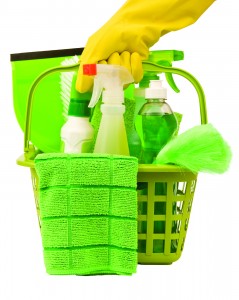 Spring cleaning is so important not only to the health of every body, but to the soul as well.
Spring cleaning is so important not only to the health of every body, but to the soul as well.
The air is clean and sweet to breathe when all the soiled particles hanging about have been eliminated.
Unfortunately, today in this world, we clean our homes only to replace the dust and dirt with chemicals that over time can be absorbed into the body, built up in the liver and fat cells, and washed down drains to pollute our ecosystem.
There are so many situations where you don’t have control of toxins such as pesticides found in our foods, water and air.
It’s a fact we live in a toxic world. So when the opportunity is at hand where there is the power to choose, choose non-toxic.
Whether you spring clean yourself or hire a company to do it, make sure non-toxic products are used for environmentally safe housekeeping. Be bold and ask to see the products used in your home. Look for chemicals such as complex phosphates, chlorinated phosphates, dry bleach, kerosene morpholine, petroleum-based surfactants, sodium bromide, glycol ether, Stoddard solvent (turpentine substitute), EDTA (ethylenediaminetetraacetic acid), naphta, ammonia, phosphoric acid, petroleum based waxes or any other non-pronounceable, unreadable ingredient.
Instead, replace with plant-based, non-toxic ones that clean just as well. Annie E. Bond, an expert on green living (anniebbond.com), highlights in one of her many books, ingredients found in the home that can be made into cleaning materials, such as baking soda, washing soda, borax, white distilled vinegar, vegetable oil based soap such as Dr. Bronner’s, lemons, and salt.
Baking soda absorbs odors, deodorizes and is a mild abrasive. Borax, disinfects and deodorizes. Lemons remove stain and tarnishes. Salt is a mild abrasive. Washing soda cuts grease. You can make washing soda from baking soda simply by pouring the baking soda in a shallow non-aluminum pan, put in oven at 400 degrees for 30 minutes or until it changes composition – white to dull grey.
There really is no reason to use products that contain toxic chemicals. And just because they are available at stores is not reassuring of their safety. Below are recipes that you can use to bring your home closer to becoming as non-toxic as possible.
Spray Cleaner: 1 teaspoon borax, ½ teaspoon washing soda, 2 tablespoons vinegar or lemon juice, ¼ to ½ teaspoon vegetable oil based liquid soap, 2 cups very hot water. Combine the borax, washing soda, white distilled vinegar and liquid soap in a spray bottle. Add very hot water, shaking the bottle gently until all the minerals have dissolved. Spray on area and wipe off with a sponge, rage or cellulose sponge cloth. Leave the washing soda out and use on appliances to disinfect, eliminate mold and make shiny. Creamy Soft Scrubber: ¼ cup baking soda, enough vegetable oil based liquid soap to make a paste. Place the baking soda in a bowl and stir in liquid soap. Scoop onto a sponge and scrub away. Disinfectant Solutions for floors: ½ cup borax, ¼ cup white vinegar, 2 gallons hot water and a few drops of lavender essential oil. Dissolve borax with vinegar in very hot water and add the drops of essential oil. Use a mop or sponge to clean, then rinse thoroughly.
Toilet Bowl Cleaner: 1 cup borax, ¼ cup vinegar or lemon juice. Pour the ingredients into the bowl. Let rest for a few hours, scrub with a toilet bowl brush then flush. Or just pour 1 cup of borax and let sit overnight. Stains lift right off and all is needed is a flush.
Wood Furniture Dusting and Cleaning Cloth: ½ teaspoon olive oil, ¼ cup vinegar or lemon juice, a soft cotton rag. Mix the ingredients in a bowl. Dab a soft rag into the solution and the dust the furniture as it shines. Rag can be reused over and over again.
Contact Gina at Ima_gina_tion@yahoo.com.




